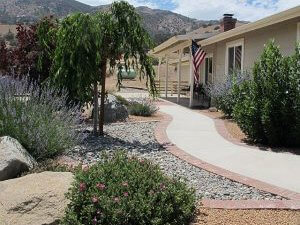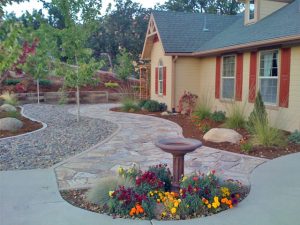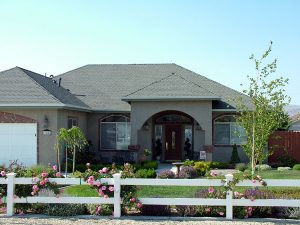 For some, sustainability means being environmentally responsible, while to others it means a garden that is very low maintenance, still other people may define it as being a landscape that is cost effective. If the words ‘sustainable landscape’ conjures up some vague image of gardens that are natural, but undefined, lets clarify. For our purposes I am going to use the definition that has been adopted by the American Association of Landscape Architects:
For some, sustainability means being environmentally responsible, while to others it means a garden that is very low maintenance, still other people may define it as being a landscape that is cost effective. If the words ‘sustainable landscape’ conjures up some vague image of gardens that are natural, but undefined, lets clarify. For our purposes I am going to use the definition that has been adopted by the American Association of Landscape Architects:
“…design, construction, operations and maintenance practices that meet the needs of the present without compromising the ability of future generations to meet their own needs”
As homeowners and institutions alike show increasing interest in sustainable landscaping their desires and goals change in some subtle and some direct ways. The attention shifts from the immediate gratification of vast expanses of resource guzzling turf and non- native, cookie -cutter landscaping, to more creative and thoughtful alternatives.
Each circumstance and site is unique and should be carefully evaluated.
Then one is in a position to set priorities and establish goals. From experienced gardeners to beginners, we can usually agree on one thing- we want to have beautiful outdoor spaces, but we do not want to be slaves to them, either financially or physically. Some goals of a sustainable landscape would include:
- Cutting down on the amount of petrochemical pesticides and herbicides used in the garden, as well as inorganic fertilizers
- Use less water by switching to drip irrigation and/or micro-sprayers
- incorporating more native plants in the garden
- Improving the soil with compost

- Reuse and repurpose items in the garden that might otherwise be thrown away
- Integrated Pest Management
- Encouraging wildlife
- Composting kitchen and garden waste.
- Mulching
Brainstorming to set priorities is where it all begins and from there goals can be established.
 If you have an existing garden take the time to really observe what is going on with it. Are the plants healthy and thriving? If not, why not? Was it poor plant choices to begin with? Are you trying to make plants work that are not well suited to the environment or the location? Is your irrigation system effective and on a regular schedule? Are you pouring lots of resources into the landscape but not seeing an improvement? Assessing what you have, setting priorities, and choosing a few realistic goals to make your garden more sustainable is doable without being overwhelming.
If you have an existing garden take the time to really observe what is going on with it. Are the plants healthy and thriving? If not, why not? Was it poor plant choices to begin with? Are you trying to make plants work that are not well suited to the environment or the location? Is your irrigation system effective and on a regular schedule? Are you pouring lots of resources into the landscape but not seeing an improvement? Assessing what you have, setting priorities, and choosing a few realistic goals to make your garden more sustainable is doable without being overwhelming.
Creating a sustainable garden on a new site has its benefits and its challenges.
On the plus side there is a blank slate to work with and you can do it right from the beginning. You can make your list of priorities and purposefully implement it in an orderly fashion that uses your resources wisely. On the down side usually most of the topsoil is scraped away as the foundation is prepared for new construction. The sub-soil that is left will need significant improvement to sustain life.
Whatever your starting point, improving the health of your garden and minimizing any negative impact it has on the environment is a good first step on the road to sustainability.
Future posts will cover the bullet points listed here in more depth. I would love to hear what some of you are doing to create a more sustainable garden. Let me know in the comments! Have a great day!






